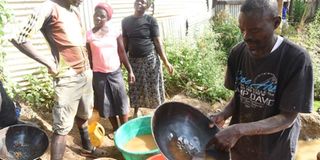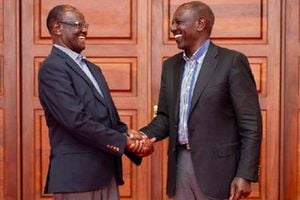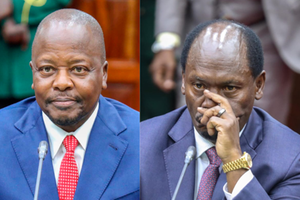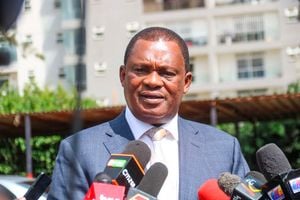Ikolomani, goldmine that has refused to yield fruits

Mr Isaac Kabaka, gold miner at Rostermines in Kakamega County, points at a sliver of gold inside a pan.
What you need to know:
- After several years searching and drilling deep holes into the depths of the earth, AfriOre woke up one morning and said they were going to sell “the gold they were sure was there” to someone else.
- The Ikolomani villagers, not knowing what coal is, concluded that it must have more money than the gold they were selling.
When, in 1996, strangers begun sneaking into Ikolomani and quietly asking after the mines the Basungu (white people) left behind, the villagers frowned and wondered: “Are they coming back?”
The Basungu had left in 1953 when political agitation for independence was peaking. But when these strangers started coming accompanied by government representatives, the villagers couldn’t ask too many questions.
“Ikolomani” is, in fact, a corruption of the English “goldmine”. It happened that, shortly afterwards, a company calling itself AfriOre followed in the footsteps of the shadowy figures and boldly announced that they had come to search for gold. The new company said that it had established that Ikolomani sat on a long belt of gold-producing rocks that spread down from Nandi all the way to Tanzania.
After several years searching and drilling deep holes into the depths of the earth, AfriOre woke up one morning and said they were going to sell “the gold they were sure was there” to someone else.
In April 2010 a company calling itself Aviva Corporation from Australia said they were buying what AfriOre had found, and that they would open a subsidiary called Aviva Mining Kenya Ltd to continue from where AfriOre left.
They were reported to have paid millions of dollars for it. The older villagers asked:“So, if you have paid millions to the people who came here but gave us nothing for what they found, are you going to give us something?”
Lindsay Reed
And they were answered by the Aviva leader, a man called Lindsay Reed, who said: “Give us time. We have come with a new way of doing things, new technology, and we are going to carry out airborne geophysics, do regional mapping and structural modelling before we determine the exact amounts and positions of the gold. ”
And, indeed, in May 2012, Aviva Mining quietly announced to the world that they had found samples of high-grade gold at the Isulu-Bushiangala area. Not many residents heard of this announcement because it was not even made to them. The few who read newspapers saw it but didn’t take it seriously.
Then it happened in October that year that it was announced that yet another company called Africa Barrick Gold was going to purchase “what had been found” from Aviva Mining. The older villagers said: “But if they found high-grade gold, why would they sell it to someone else while it is still in the ground? Why not bring it up themselves?” When the youth took this question to Reed he said: “It is because we need the money to invest in coal mining in Botswana.”
The Ikolomani villagers, not knowing what coal is, concluded that it must have more money than the gold they were selling. After all, a man can sell his two ducks to buy a young goat. It was reported that the owners of Africa Barrick Gold, Barrick Gold Corporation of Canada, had paid US$20 million to Aviva.
So, there now came Acacia Exploration Kenya Ltd, bringing with them drilling companies bearing sophisticated equipment and advanced machinery. Their coming was heralded by disturbing sweeps across the whole breath of Ikolomani skies by helicopters. The villagers sent emissaries to the new team leader, this time a woman called Philippa Hutchinson, who said that the helicopters were searching for gold from the air. It was quite a relief when, in February 2017, the owners of Acacia Exploration, Africa Barrick Gold, announced that after spending US$3.1 billion on exploration work, they had discovered viable, high-grade gold deposits approximating 1.3 million ounces, that would translate to about Sh171 billion when brought up and sold. They said this discovery had been made in the Lirhanda Corridor. Villages resounded with jubilation. Finally, the name “Ikolomani” would vindicate itself!
Good news
But as usually happens, all good news comes with a dose of the bad. Acacia Exploration quickly followed on what had been announced with:“Some three or more years of work are required to fully confirm the existence of the discovery.
A lot of money and work is needed before mining, if any, can be commenced”. And the elderly of Ikolomani wondered: “How do you find something and you still have to confirm it? Let them cheat the bushes!”
The Bidakho sub-tribe of Ikolomani believe that one can refuse you food, but not words. Shortly after, word reached them to the effect that the parent company of Acacia Exploration in Kenya, Acacia Mining Ltd in Tanzania, had fallen foul of no-nonsense President John Pombe Magufuli.
It was said Acacia Mining had for many years “deliberately failed to pay taxes and royalties to the Tanzania government”. Consequently, it was forced to pay what had been evaded, and with a hefty fine on top. It declined to pay fully and the parent company — Africa Barrick Gold — was forced step in and mend fences with the Tanzanian government.
Thereafter, it bought out the recalcitrant managers of Acacia Mining and created a new, cleaner outfit to look after its mines in Tanzania. But in the process, it had inherited Acacia Exploration Kenya Ltd with all its on-going activities, including the Isulu-Bushiangala deposit.
Richest gold miner
By 2018, Philippa Hutchinson was admitting that what they had been supporting in Ikolomani had to come to an end; that, until Africa Barrick Gold found another investor “willing to come in and inject more funds in a joint venture arrangement.” The Bidakho now asked: “But, Africa Barrick Gold is the child of Barrick Gold Corporation, the richest gold miner in the world.
How can they lack money to give you?” They were shocked, all of them, when she answered that: “Africa Barrick Gold needs a joint-venture partner, not just for their money, but because the Isulu-Bushiangala deposits “are too narrow for its standard mining equipment and too little in quantity. There are smaller miners, however, better equipped to commercially mine the deposits we have found.”
The older Bidakho twisted their lips, looked to the side and asked:“If they knew that, why did they pay Aviva so much money? And, all these years they have been drilling, what were they taking out?” They then looked the younger Bidakho in the eye and said: “You may be putting the water-pots out when the rain has stopped falling.”
And the dream fizzled out once more. Still, 2019 and 2020 have seen a number of other strangers come to Ikolomani, walk around with the Acacia Exploration team, visit their well-guarded camps, and go away. When Bidakho have inquired from the community committee members what is happening, they have been told that “these people are prospective joint partners carrying out due diligence surveys before they decide to invest”.
And so, it was with a little relief that many Bidakho read in the papers and on their smart phones that effective August 19, Shanta Gold Ltd of the UK had purchased Acacia Exploration with all its exploration activities and the Isulu-Bushiangala deposit from Africa Barrick Gold for yet another huge sum of money.
This time, the older Bidakho have only shrugged their shoulder in a typical Idakho way of saying “it is not worth disturbing my ears for.” The younger, more questioning Bidakho are asking: “What is new that Shanta is coming to do that all these others did not do for us?”
These younger Bidakho have read the Mining Act 2016 and realised that there is provision in this law for specific benefits to communities in whose environs mineral wealth is found and commercially exploited. They have learned that the law talks of “local content” and compels companies to fully and democratically give priority to qualified local personnel whenever employment opportunities arise.
That the law makes specific pronouncements regarding royalty earnings accruing from the sale of mineral extractives. That it recognises artisanal mining as a key community industry. They have learned that in the case of mining gold, the residual tailings left after refining the gold ore are the property of the community. These “younger” Bidakho have grown tired of the receding dream. So, as the older Bidakho sit on their doorsteps soaking in the afternoon sun, the younger ones will be asking informed questions to Shanta Gold and the State Department of Mining. Bindu bichenganga.
Jemima Bonso is a resident of Ikolomani




